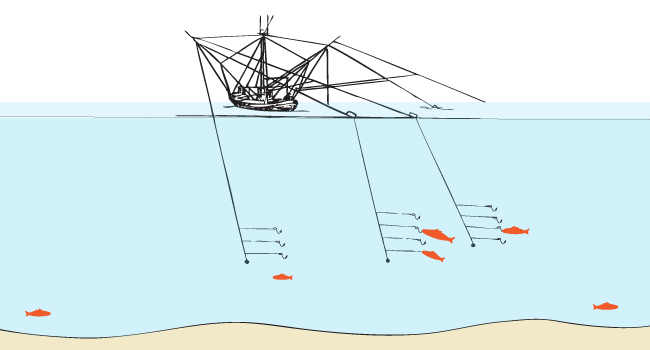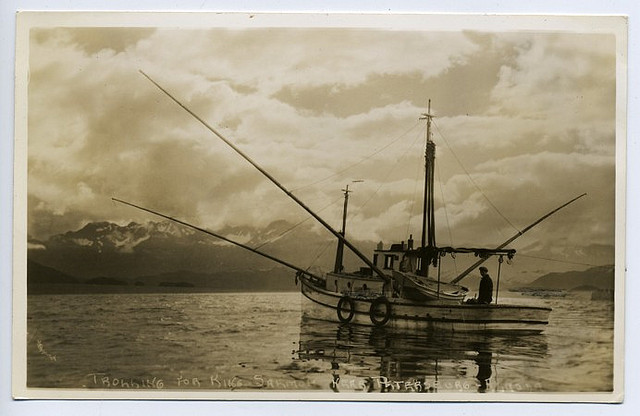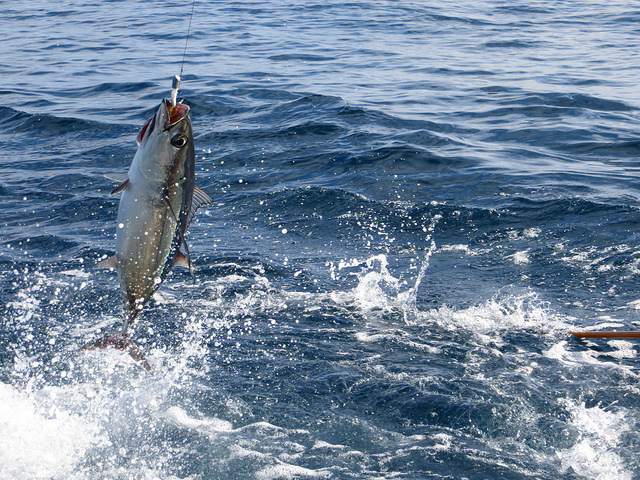WHAT IS TROLLING?
Trolling is one of the most sustainable commercial fisheries. Lines are pretty much constantly being checked throughout the fishing period and so even if a non-target species is on a hook they can be released quite quickly and unlike with some other fishing methods the released fish has a decent chance of recovering. However, trolling can be somewhat inefficient compared to other methods and it is impossible to catch the sheer numbers that are caught by most fisheries using a net of some sort. The main benefit to trolling is that they typically catch the highest quality fish (especially when it comes to salmon). By catching fish on individual lines and hooks the fish don’t have any net marks, much less bruising and most trollers clean and ice each fish as it comes on board which makes the resulting product some of the highest quality seafood in the world. Troll-caught fish are also typically caught in the open ocean which adds to the quality and freshness of the fish.

A fishing boat designed for trolling will have outrigger poles on each side as shown in the image above. When these are put out to the sides it allows the fisherman to keep his lines spread out to minimise tangles and fish a larger area of water. Depending on the location of the fishery a boat will have 2-3 lines out each side. On the bottom of each line is a lead ball that weighs between 20 and 80 pounds (depending on the boat and depth the fisherman is trying to reach). Heavy balls like this need to be used because to catch King Salmon a lot of fishermen have their gear down between 120 and 180 feet. Depending on the fishery trollers also target Silver and Chum Salmon (Alaska, Washington, Oregon) and Albacore Tuna (Pacific and Atlantic Oceans). Along each of the 4-6 (total) main lines there will be multiple hooks. When fishing for King Salmon there will be less hooks with long leaders (the leader is the fishing line between the mainline and hook/bait) and when fishing for Chum Salmon the leaders will be shorter and this allows the fisherman to have more hooks in the water at once. Quite often a fisherman will use what is called a flasher or metal spoon on the leader to attract the fish so they will bite the hook. The hook itself might have bait on it such as herring or a hoochie may also be used. Quite often the fisherman will place bells on his lines so he will know when a fish hits. He/she will than bring the line in with hydraulics until the last section where they will fight the fish by hand and gaff it in the head as soon as possible. For this method of commercial fishing the best numbers I have heard of is 250 King Salmon in a day and 400 Silver Salmon in a day.
A BRIEF HISTORY OF TROLLING

It is difficult to ascertain the date when people started to use trolling as a method of commercial fishing. Many people in developing nations have been trolling with lines from their canoes for 100’s of years but a lot of that is for personal or very small-scale commercial use. In Alaska, commercial trolling has been going on since at least the 1930’s. In the early days fishermen would not have had hydraulics so it must have been a very hard fishery. However, these days in Alaska there are some fisherman who do not use hydraulics and instead hand troll. They must crank in each line by hand so the lead balls are usually on the lighter side. Unlike other salmon fisheries, trolling even has a winter season. The winter troll season in Southeast Alaska was officially established in 1981. The winter season is usually very cold and lonely but some guys do pretty good, especially when prices are around double what they get during the summer.
TROLLING TODAY
Trolling today is much the same as it has always been other than a few different regulations and the invention of hydraulics. At the end of the day the only way to catch salmon trolling is to steer your boat in circles day after day for weeks on end. I have friends that say it is fun but I don’t know about that, haha. I guess the main development in trolling (other than technology upgrades with radar, sonar etc) is the increased quality a troller is able to provide. There are even some trollers who are able to flash freeze their salmon right after they have been caught and cleaned which makes it one of the highest quality seafood products on the market.
ENVIRONMENTAL CONCERNS
Unlike some commercial fisheries (such as trawling), trolling has very little negative impact on the environment and fisheries. Other than the odd accidental lead ball bouncing off the bottom of the ocean there is pretty much no risk of habitat destruction and lost trolling gear just sinks to the bottom so it doesn’t keep fishing like some pots or nets. There is also minimal by-catch associated with trolling for salmon and tuna. Any non-target species that are caught can be released quickly back into the water.

The only ‘problem’ with trolling (and it is not an environmental one) is the fact that trollers cannot catch that many fish compared to fisheries like trawling, seining or gillnetting. For instance, as of 2009 only 11% of commercially caught tuna was caught on pole and line or trolling. I don’t really see how trollers can become much more efficient either. Although this fishery seems very sustainable I can’t see the fishery size increasing to make up for a more unsustainable fishing method due to this fact.